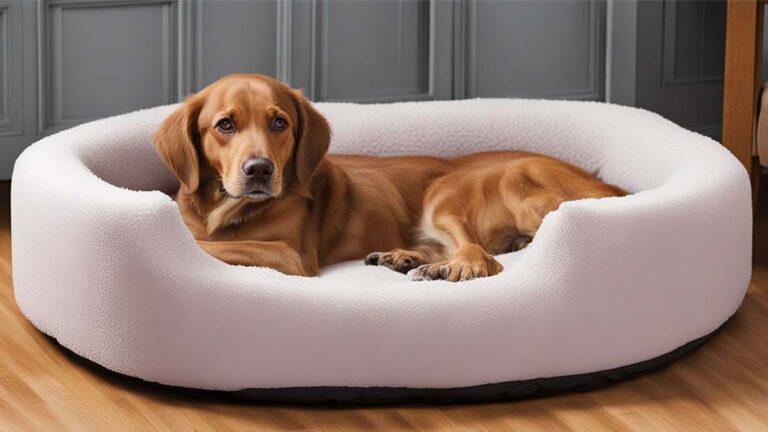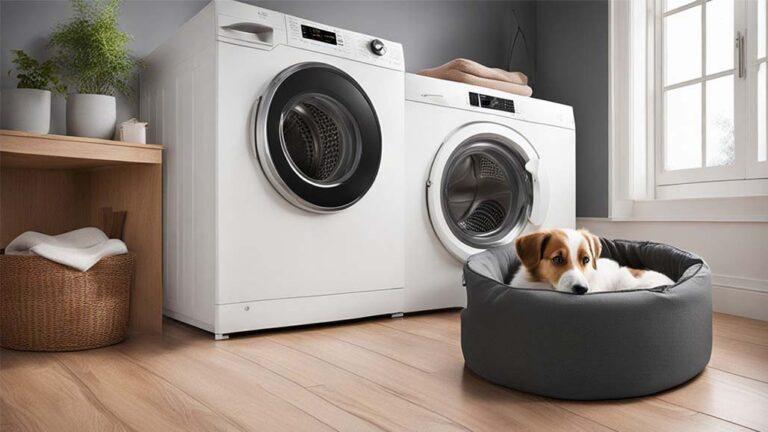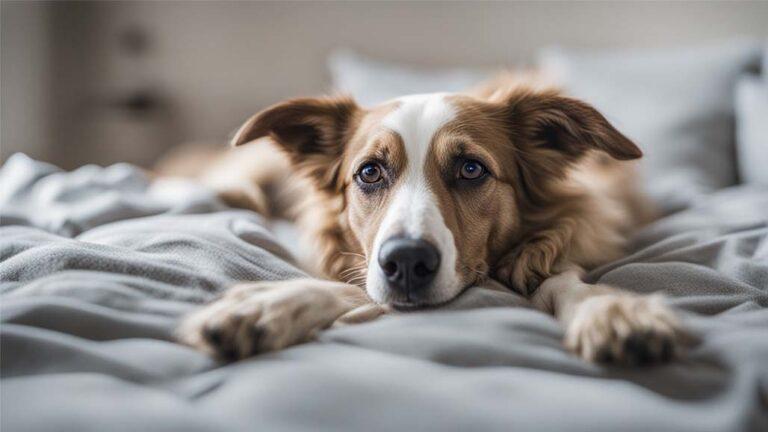
Introduction
The best pet food storage container for Fresh and wholesome food is a major priority when it comes to taking care of our cherished pets. The quality of your pet’s food must be preserved through proper storage. The way your pet’s meals are kept fresh, free of insects, and cross-contamination-free depends heavily on the type of pet food storage container you select.
In this in-depth overview, we are going to review all of the pet food storage choices while talking about the value of maintaining proper pet food storage. We will also provide you with smart advice on how to select the best pet food storage container. In order to ensure that your beloved buddy receives the greatest nutrition possible. Let’s set out to see this guide to find the best pet food storage container.
Why Is It Important to Store Pet Food Properly?
1. To Keep It Fresh and Nutritious
Similar to human food the nutritional value of pet food is greatly influenced by how recently it was produced. The creation of wholesome well-balanced meals for our pets takes a lot of time and work on the part of pet food makers. These efforts, nevertheless can be in vain if the food is not preserved properly.
When it comes to pet food, oxygen, light, and temperature are the enemies of freshness. Fats in food can oxidize when exposed to oxygen, which causes rancidity. Vital vitamins and nutrients can be destroyed by light thus reducing the food’s nutritious value. The quality of the meal might also be impacted by temperature changes.
Your pet will receive the best nutrition possible if you buy the best pet food storage container that keeps food fresh and nutrient-rich.
2. To Prevent Pests from Getting In
Imagine opening the food container for your pet only to discover that it is full of rats, roaches, or even ants. This not only wastes food but endangers the health of your dogs. Pests are invited inside when pet food is kept in its original bag or a thin container.Now choose the best pet food storage container
An appropriate pet food storage container is made to be pest- and airtight. Access points that would otherwise be open to pests and rats are sealed off. This not only safeguards your pet’s food but also keeps your pet’s health.
3. To Avoid Cross-Contamination
When your pet’s food comes into contact with other home goods or substances cross-contamination may happen. There is a chance of contamination for instance. if you keep cleaning supplies in the same cabinet as your pet food in an accessible container. The effect of this could be for your pet health issues.
The food for your pet is kept separate and clean by using a particular best pet food storage container. It maintains your living food environment neat and fresh by preventing aromas from invading your kitchen or storage area.
What Are the Different Types of Pet Food Storage Containers?
Now that we understand why it’s vital to store pet food properly. Let’s explore the various types of best pet food storage containers available on the market. Each type has its pros and cons so it’s essential to choose the one that best suits your needs.
1. Plastic Containers
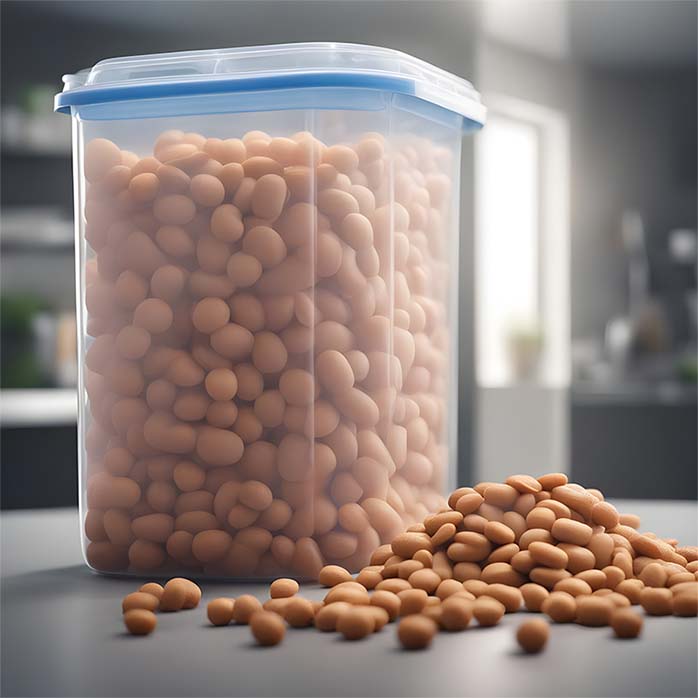
Plastic pet food containers are among the most popular choices due to their affordability. They come in various sizes making it easy to find one that fits your pet’s food containers. Here are some pros and cons:
| Pros | Cons |
|---|---|
| Affordable: Plastic containers are budget-friendly and readily accessible. | Not Always Airtight: Not all plastic containers are airtight, so you need to choose carefully. |
| Lightweight: They are easy to handle and move around. | Durability: They may not be as durable as other materials, especially with heavy daily use. |
| Various Sizes: You can find plastic containers in sizes suitable for different container volumes | Potential for Odors: Plastic containers can absorb food odors over time. |
| Airtight Options: Some plastic containers come with airtight seals to maintain freshness. |
2. Glass Containers
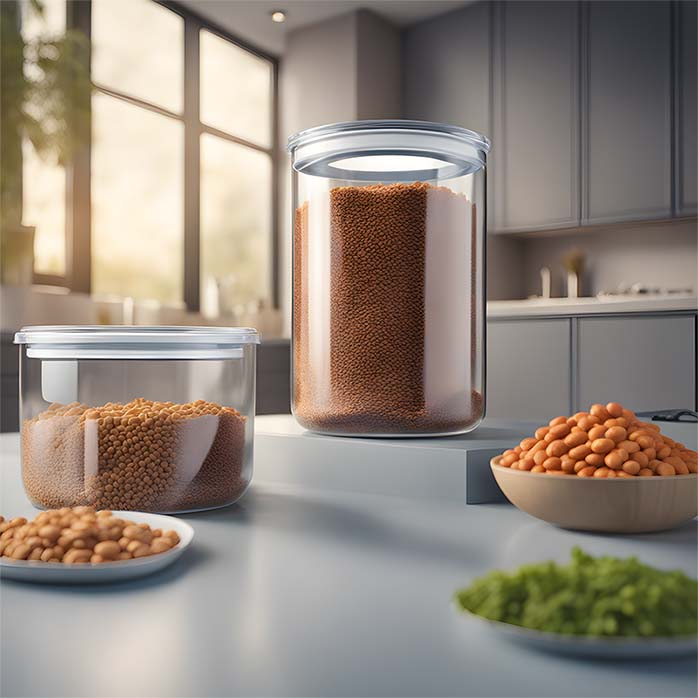
Glass pet food containers offer several advantages, primarily in terms of preserving food quality and avoiding potential chemical leaching from plastic. However, they also have some drawbacks:
| Pros | Cons |
|---|---|
| Preserves Freshness: Glass is non-porous, ensuring that no odors or flavors are absorbed, which can happen with plastic. | Heavier: Glass containers are heavier and more cumbersome than plastic. |
| Durability: Glass containers are sturdy and durable, lasting for years. | Breakable: They are prone to breakage if dropped. |
| Transparency: How much food is still left is clearly visible. | Limited Sizes: Finding large glass containers for pet food can be challenging. |
3. Metal Containers
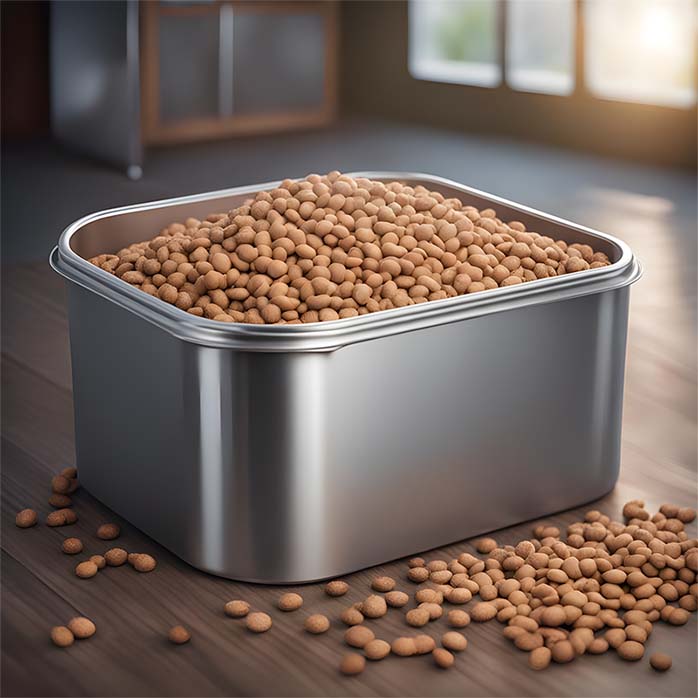
Metal pet food containers are less common but have their unique advantages and disadvantages. They are often made of stainless steel and offer a more robust storage option:
| Pros | Cons |
|---|---|
| Durability: Stainless steel containers are incredibly durable and resistant to rust and corrosion. | Cost: Metal containers tend to be more expensive than plastic alternatives. |
| Airtight: Many metal containers come with airtight seals. | Weight: They can be heavy, making them less portable. |
| Pest-Proof: Metal is highly effective at keeping pests out. | Limited Styles: There may be fewer design options available compared to plastic or glass. |
How to Choose the Best Pet Food Storage Container for Your Needs
Choosing the best pet food storage container involves considering various factors to meet your specific requirements. The following are important standards to bear in mind:
1. Consider the Size of Your Pet Food Bag
The size of your pet food bag determines the capacity you need in a best pet food storage container. Measure the food dimensions or check its label for information on volume. Ideally, the container should comfortably accommodate the entire food with some space.
2. Choose a Container That Is Airtight and Pest-Proof
To ensure your pet’s food stays fresh and pest-free, opt for a container with a reliable airtight seal. This seal prevents air, moisture, and pests from the container, safeguarding the food’s quality.
3. Look for a Container That Is Easy to Clean and Maintain
Cleaning and maintaining your best pet food storage container is crucial to prevent bacterial growth and odors. Select a container with smooth, non-porous surfaces that are easy to clean. Some containers even feature removable inner liners for added convenience.
4. Consider Your Available Storage Space
Before purchasing a pet food container assess the space where you intend to store it. Ensure that the container’s size and shape fit comfortably in your designated storage area, whether it’s a pantry, closet, or garage.
5. Evaluate Your Mobility Needs
If you need to move the container frequently, consider its weight and the presence of handles or wheels for easy transport. Lightweight plastic containers are often more suitable for this purpose.
6. Assess Your Aesthetic Preferences
While not a primary concern, the appearance and design of the container matter to some pet owners. Choose the best pet food storage container. That aligns with your style preferences and complements your home decor.
Pet Food Storage Container Maintenance
Selecting the best pet food storage container is just the beginning of ensuring the freshness and safety of your pet’s meals. Maintenance is key to preserving the quality of the stored food and the container itself. Here are some points to understand the maintenance of this container.
1. Cleaning and Maintenance
Regardless of the material, regular cleaning and maintenance are essential for the longevity of your best pet food storage container. Follow these steps to keep your container in optimal condition:
- Empty and Clean: When you are near the bottom of the container, empty it entirely. Use a pet-safe detergent to wash the container thoroughly. Rinse it multiple times to ensure no soap residue remains.
- Dry Completely: After washing, let the container air dry completely before refilling it. Mold and germs can grow more readily in moist environments.
- Check for Wear and Tear: Regularly inspect the container for any signs of wear, such as cracks, scratches, or loose seals. Address any issues promptly to maintain the container’s integrity.
- Replace Seals as Needed: If your container has rubber or silicone seals, check them regularly for wear. These seals may become ineffective over time.
- Inspect for Pest Entry Points: For pest-proof containers, make sure there are no entry points for rodents or insects. Even small gaps or cracks can allow pests to access the stored food.
2. Hygiene Practices
Maintaining good hygiene practices while handling pet food is essential for your pet’s health. Here are some suggestions for good hygiene:
- Handwashing: Wash your hands thoroughly before and after handling pet food, scoops, or containers. This helps prevent the spread of bacteria to your pet’s food and reduces the risk of contamination.
- Scoop Usage: Use a dedicated scoop for pet food rather than your hands. This minimizes the transfer of bacteria and keeps the food cleaner.
- Wash Scoops and Bowls: Wash the pet food scoop and your pet’s food and water bowls regularly. Use hot, soapy water, and rinse them thoroughly. Dry to before refilling.
- Dispose of Expired Food: Check the expiration date on pet food packaging. If the food has expired or shows signs of spoilage, dispose of it properly and clean the container before refilling.
3. Monitoring and Rotation
To ensure your pet always enjoys fresh and nutritious meals, adopt a system of monitoring and food rotation:
- Regularly Check the Container: Keep an eye on the level of food in the container. When it’s running low, it’s an opportunity to thoroughly clean the container before refilling.
- Practice FIFO: Implement the “First In, First Out” (FIFO) principle by using older food before adding newer batches. This prevents food from sitting in the container for extended periods.
- Review Best Before Dates: Pay attention to the “best before” or “use by” dates on pet food packaging. If you have multiple bags, be mindful of the expiration dates and prioritize the oldest ones.
- Avoid Overstocking: While it’s convenient to buy pet food in bulk, avoid overstocking to the extent that food remains in the container for months. Purchase only what your pet can consume in a reasonable time frame.
By incorporating these cleaning and hygiene practices and establishing a monitoring and rotation system, you’ll not only maintain the quality of your pet’s food but also ensure the longevity of your chosen best pet food storage container.
Environmental Considerations
While choosing and maintaining a best pet food storage container, it’s essential to consider the environmental impact of your choices. Sustainable practices benefit not only your pet but also the planet. Here are some eco-friendly considerations:
- Recyclable Materials: Look for containers made from recyclable materials. Many best pet food storage container manufacturers are now using eco-friendly plastics or other recyclable materials.
- Reusable Options: Some containers are designed for long-term use and can be refilled countless times. Opting for a durable, reusable container reduces the need for single-use plastic bags.
- Proper Disposal: If you do use plastic containers, make sure to dispose of them responsibly. Recycling or reusing plastic containers is a small step towards reducing waste.
- Biodegradable Bags: Consider using biodegradable pet waste bags for disposing of empty pet food bags. These bags break down more easily in landfills compared to traditional plastic bags.
- Support Eco-Conscious Brands: Research and choose pet food brands that prioritize sustainability in their packaging and production processes. Supporting such brands encourages eco-friendly practices.
Customizing for Your Pet’s Needs
Every pet is unique, and their dietary requirements can vary. Tailoring your best pet food storage container approach to your specific pet’s needs can further enhance their dining experience. Here are some customization ideas:
- Allergen Separation: If your pet has allergies or dietary restrictions, consider using separate containers for different types of food to prevent cross-contamination.
- Multiple Food Types: Some pet owners have pets with different dietary needs. In such cases, having multiple containers can help you organize and store various types of food.
- Portion Control: If you’re managing your pet’s weight or need precise portion control, select containers with measurement markings to ensure accurate serving sizes.
- Food Accessibility: Depending on your pet’s size and accessibility needs, choose a container that allows for easy scooping or pouring.
- Travel-Friendly Options: If you frequently travel with your pet, look for containers that are designed for portability. These may include built-in handles or smaller, stackable options for packing.
Customizing your pet food storage strategy to match your pet’s unique requirements can simplify feeding routines and contribute to their overall well-being.
Pet Food Storage: A Comprehensive Guide to Optimal Practices
We go deeper into the nuances of keeping your pet’s meals healthy, fresh, and safe in our expanded guide to pet food storage. Our goal is to provide you with the information and resources you need to care for your furry friends as successfully as possible. Let us look at some creative ideas and methods for storing pet food.
Understanding Your Pet’s Dietary Needs
Before delving into advanced pet food storage techniques, it’s essential to have a clear understanding of your pet’s dietary requirements. Different pets have varying nutritional needs based on factors such as age breed size, and activity level. Consult with your veterinarian to determine the ideal type of food and feeding schedule for your pet.
The Role of Treats and Supplements
In addition to their regular meals, many pets enjoy treats and may require dietary supplements for optimal health. When storing these items, consider the following:
- Treat Storage: Treats should be stored in airtight containers just like regular pet food. The same principles of freshness and preventing pests apply. It’s also important to monitor your pet’s treatment intake to avoid overindulgence, which can lead to weight gain.
- Supplements: If your pet requires dietary supplements, follow the manufacturer’s storage instructions carefully. Some supplements may require refrigeration to maintain their efficacy.
Seasonal Considerations
Extreme temperatures, whether hot or cold, can affect the quality and safety of your pet’s food. Here’s how to address seasonal challenges:
- Summer Storage: During hot summer months, it’s crucial to keep pet food cool and dry. Consider storing it in a temperature-controlled area or using insulating covers to shield it from direct sunlight.
- Winter Storage: In cold climates, pet food can freeze, potentially compromising its texture and nutritional value. If freezing is a concern, choose storage containers that offer insulation or use a heated storage area.
The Importance of Rotation
Rotating your pet’s food ensures they receive a variety of nutrients and prevents them from becoming bored with their meals. Here are some rotation strategies:
- Brand Rotation: Alternate between different brands or product lines to provide diverse flavors and ingredient profiles.
- Protein Rotation: If your pet’s diet allows, rotate between protein sources like chicken, beef, and fish to offer a well-rounded diet.
- Homemade Meals: If you prepare homemade meals for your pet, consult with a veterinary nutritionist to create a balanced rotation plan.
Hygiene and Food Safety
Maintaining cleanliness and practicing proper food safety measures are paramount when handling pet food. Here are some advanced hygiene tips:
- Food Scoops: Consider using separate scoops for dry and wet food to prevent cross-contamination. Wash scoops after each use thoroughly.
- Hand Washing: Wash your hands before and after handling pet food to avoid transferring bacteria.
- Cleaning Containers: When refilling the storage container, clean it meticulously to remove any remaining crumbs or oils that can attract pests.
Monitoring Food Quality
As pet food sits in storage, its quality can deteriorate. Pay attention to these quality indicators:
- Smell: If the food develops an off or rancid smell, it’s best to discard it.
- Texture: Inspect the food for any changes in texture, such as clumps or excessive dryness, which may indicate spoilage.
- Appearance: Check for any signs of mold, discoloration, or unusual spots in the kibble.
Emergency Preparedness
Prepare for unforeseen emergencies that may disrupt your pet’s food supply. Consider creating an emergency kit that includes a supply of your pet’s food, bottled water, bowls, and any necessary medications. Ensure the kit is easily accessible in case you need to evacuate or face extended power outages.
Sustainable Pet Food Storage
For environmentally-conscious pet owners sustainability is a growing concern. Look for eco-friendly pet food storage options. Such as containers made from recycled materials or those designed for long-term use to reduce waste.
You can guarantee that your furry friends receive the highest nutrition, freshness, and safety by adding these cutting-edge tactics and considerations into your pet food storage practice. Keep in mind that your dedication to their welfare will go a long way toward ensuring their happiness and health for years to come.
Advanced Pet Food Storage Tips and Best Practices
In our quest to provide you with the most comprehensive guide to the best pet food storage container. We will delve even deeper into advanced techniques and best practices. By following these recommendations you will be well-equipped to ensure the health and happiness of your beloved pets.
Customized Feeding Plans
As we’ve emphasized earlier, every pet is unique, and their dietary needs can vary significantly. To optimize their health, consider a customized feeding plan:
- Consult with a Nutritionist: If your pet has specific health concerns or dietary requirements, consult with a veterinary nutritionist. They can create a personalized feeding plan tailored to your pet’s needs.
- Age-Appropriate Feeding: As pets age, their nutritional needs change. Puppies and kittens have different requirements than adult or senior pets. Adjust their diet accordingly.
- Scheduled Feeding: Establish a consistent feeding schedule. This not only helps with portion control but also ensures your pet receives meals at regular intervals, reducing the chances of overeating.
The Benefits of Portion Control
Portion control plays a crucial role in your pet’s health, particularly in preventing obesity, which can lead to various health issues. Consider these strategies:
- Measuring Meals: Use a kitchen scale or measuring cup to accurately portion your pet’s meals. This practice helps avoid overfeeding and ensures your pet receives the right amount of food for their size and activity level.
- Feeding Guidelines: Many pet food manufacturers provide feeding guidelines based on your pet’s weight and activity level. These guidelines can be a helpful starting point for portion control.
- Treat Management: Be mindful of the treats you offer your pet. They should complement, not replace, their regular meals. Consider low-calorie treats or use a portion of their kibble as treats.
Long-Term Storage Solutions
For those who prefer buying pet food in bulk or want to ensure long-term food storage containers freshness, here are some advanced storage solutions:
- Vacuum Sealing: Vacuum-sealed bags or containers can remove excess air and maintain freshness. Just be sure to transfer the food to an airtight container after opening the original bag.
- Food Rotation: When storing bulk food, use the “first in, first out” principle. This means using older stock first to prevent food from expiring.
- Storage Duration: Check the “best by” or “use by” dates on pet food bags. It’s best to purchase food with a reasonable shelf life and use it within that time frame for optimal freshness.
Pet-Specific Storage Considerations
Certain pets have unique storage needs, particularly those with special dietary requirements or sensitivities:
- Grain-Free Diets: If your pet requires a grain-free diet, be extra vigilant about storage. Grain-free kibble can be more susceptible to spoilage, so ensure airtight storage and regular inspections.
- Prescription Diets: Pets with medical conditions often require prescription diets. Follow your veterinarian’s storage recommendations to maintain the food’s therapeutic properties.
Maintaining a Pet Food Storage Journal
For those truly dedicated to their pet’s well-being, consider keeping a pet food storage journal. This journal can help you track food quality, consumption patterns, and any adverse reactions. Include the following details:
- Purchase Date: Record when you buy each bag or container of pet food.
- Food Quality Notes: Regularly inspect the food for any signs of spoilage, including smell, texture, and appearance.
- Feeding Schedule: Track your pet’s feeding schedule, including portion sizes and any treats given.
- Health Observations: Note any changes in your pet’s health, such as allergies, digestive issues, or changes in coat condition. Your doctor could benefit from knowing this information.
By maintaining a pet food storage journal, you can proactively address any issues related to your pet’s diet and ensure their well-being.
Choosing the Right Pet Food Storage Container
1. Airtight Containers
Regardless of the material you choose, it’s essential to prioritize airtight containers for pet food storage. Airtight containers seal tightly, preventing air and moisture from entering and food odors from escaping. This extends the shelf life of pet food and keeps it fresh and appetizing for your furry friend.
2. Stackable Containers
For those with limited storage space, stackable containers can be a game-changer. These containers are designed to fit neatly on top of each other, maximizing vertical storage. They often come in a modular system, allowing you to stack different sizes for various types of pet food.
Conclusion
Choosing the best pet food storage container is a critical step in ensuring the health and well-being of your furry companion. By following the guidelines outlined in this comprehensive guide, you can make an informed decision that suits your specific needs and preferences.
Remember that proper pet food storage goes beyond convenience it directly impacts the freshness and nutritional value of your pet’s meals. Whether you opt for a plastic, glass, metal, airtight, or stackable container, prioritize features like airtight seals, durability, and ease of maintenance to keep your pet’s food in optimal condition.
Investing in the best pet food storage container is a small yet meaningful way to show your love and care for your pet. By providing them with fresh, high-quality meals, you’re contributing to their overall health, happiness, and longevity.
So, embark on the journey of finding the best pet food storage container for your beloved furry friend, and rest assured that you’re taking a significant step towards providing them with the best nutrition possible. Your pet’s well-deserved satisfaction and affection are your greatest rewards.

